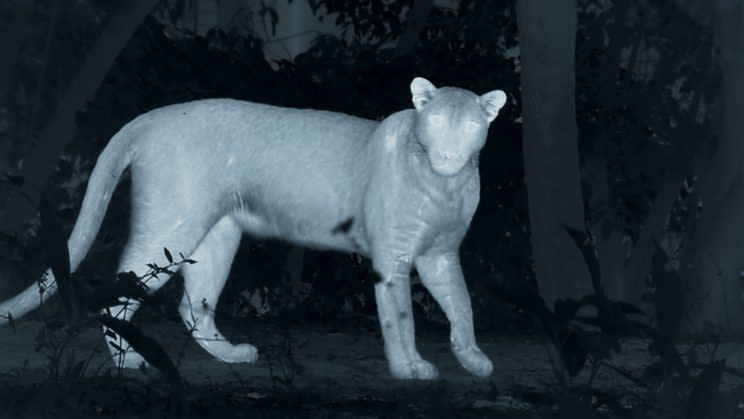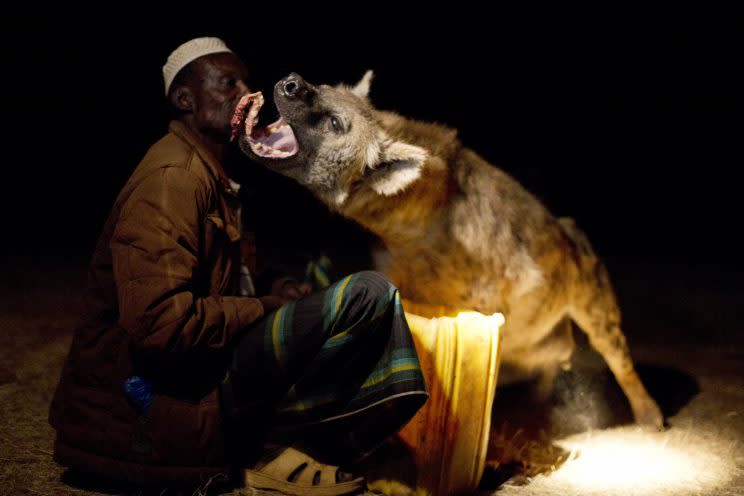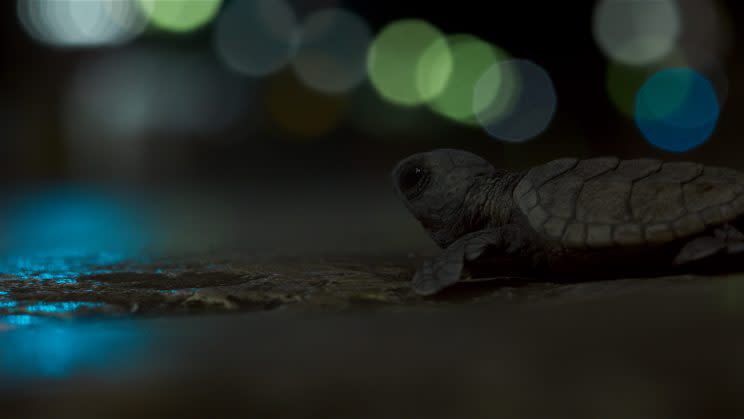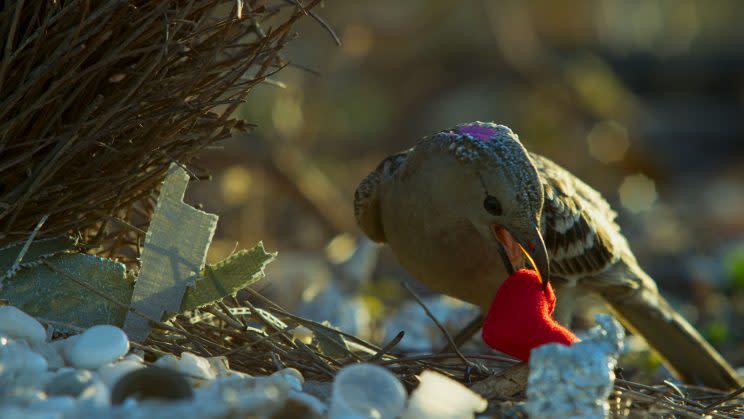‘Planet Earth II’ Preview: Watch Leopards Hunt in the City of Mumbai
BBC America’s Planet Earth II comes to a dramatic conclusion on Saturday night with two of its most fascinating hours: the much-anticipated “Cities” episode (9 p.m.), which includes thermal camera footage (see our exclusive sneak peek above) of leopards prowling for domesticated pigs in Mumbai, India, followed by “The Making of Planet Earth II” (10 p.m.), which takes viewers into the field to reveal how some of the series’ most memorable moments, including that one, were filmed.
Here, “Cities” producer/director Fredi Devas and series executive producer Mike Gunton preview seven key sequences.
Leopards Snatch Piglets in Mumbai, India
It took cameraman Gordon Buchanan a month to successfully film the first-ever footage of leopards hunting in Mumbai, which has the highest concentration of leopards anywhere in the world. The elusive animals — which have attacked humans — use the cover of night and urban noise to stalk their preferred prey: pigs and stray dogs.
A team of Indian conservation scientists had set up remote control camera traps in preceding months to monitor the leopards’ movements, as did the Planet Earth II crew when they arrived. Each morning the camera trap footage would be checked, and each night, Buchanan would decide where to set up his “hide,” a thinly-veiled location where he’d sit and wait with a thermal camera that captures body heat even through foliage.

“So Gordon would go out every single night and spend the entire night on his own just looking out for leopards,” says Devas. “At the time, I was filming another sequence with the langurs up in Jodhpur, so I thought that Gordon would have another person with him in the hide. But he knows leopards incredibly well, and he knows the risk he was taking, and he’s truly dedicated. He was the man for the job because he worked tirelessly every night to just keep his attention down there. There were nights that would pass where he wouldn’t see a leopard at all, and lots of nights where he’d just get little glimpses of them, and then all of a sudden something big would happen, like a predation, and then he would get to capture it.”
Yes, the footage of a successful hunt is heartbreaking (“I’ve seen a lot more footage than is in the sequence, so I know that on occasion the mother was able to defend her piglet and chase the leopard away, which was extraordinary,” Devas says), but livestock becoming prey is to be expected when humans bring so much into the city. What surprised Devas was seeing how close humans walk to leopards at night — whether or not they know it. “Mumbai has got over 20 million people living in that city. There have been nearly 200 attacks from leopards on people in the last 25 years. So this is something that the people are aware of, and yet they choose to live side by side with the leopard, even facing this enormous risk. I can’t think of another country that wouldn’t have darted those leopards and relocated them somewhere else. But instead, they maintain this policy of ‘Let’s learn from each other and let’s see if we can live harmoniously side by side,'” he says. “It’s not there yet, but they’re making extremely good progress.”

Spotted Hyenas Peacefully Roam the Streets of Harar, Ethiopia
Odds are if you’ve seen spotted hyenas in most any other nature series, you are not a fan. But Planet Earth 2 shows a different side to them entirely. Two hyena clans fight each night outside the city wall of Harar, Ethiopia, to see who will enter that evening and partake of the bones that butchers have tossed out on the street for them (a 400-year-old tradition) — and whatever scraps Yusef, pictured above, would like to hand-feed them. Hyenas are the second largest land predator in Africa, after the lion, and aren’t above grabbing small children in other villages, but they seem to have an unspoken agreement with the residents of Harar, who invite them in because they believe they also eat the bad spirits that haunt the streets.

Devas had to see the hyenas himself to believe it. When he was younger, he was on a walking safari in Uganda with a friend and a guide when two spotted hyenas started circling them as they were headed back to camp. “I turned to the guide and said, ‘Do you have any bullets for that gun?’ And he said, ‘No,’ which was what I was anticipating. And I said, ‘Well, should we run?’ And he said, ‘Yes,’ so we legged it all the way back to camp. I mean we were really quite terrified of these hyenas getting closer and closer,” he says. “And so I went to Harar, and on my first night that I was there, I was on my own, and it was 4 o’clock in the morning, and I turned down this very dark, narrow alleyway and eight hyenas started coming towards me. They walked straight past me and two of them brushed my leg. And at that point, I thought, ‘What am I doing?’ I’m on my own, and if they turn on me I’m finished in seconds, and I’m a good-sized meal for those hyenas. But it was extraordinary that they could come that close but that was not on their minds. And that’s what made me realize that this really was a peaceful pact between man and beast in this city.”
Devas spoke with the mayor of Mumbai, who had street lights fixed so that his crew would have enough light to film the hyenas’ walk using the latest 4K low-light cameras. But he didn’t foresee another issue: “So much of the animal behavior in cities happens at night, and so you find yourself up at 4 o’clock in the morning regularly trying to film this behavior, and then you meet a lot of interesting characters. There was one particular time where I had to deal with a man who was inebriated for a very, very long time,” he says. “He kept wanting to help, and then wanting to question [what we were doing]. It was a funny situation where you’re surrounded by hyenas, but actually the major risk is the mood that you find a passerby in. But really, the overall sentiment was just being amazed at how generous people were with allowing us access to their houses and their gardens as we’re filming wild animals walking through their streets.”

Rhesus Macaques Go to the Market in Jaipur, India
Macaques in Jaipur do not have a pact with the market vendors and customers they steal from on a daily basis. The brazen thieves take the same route each day through the city, which meant the crew could plan ahead to follow them on foot, in vehicles, and, most impressively, by rigging a camera to a cable dolly that went from rooftop to rooftop. “We were mainly based around a house that has been claimed by the macaques — these macaques have moved in, that’s where they sleep at night, indoors, and then when the sun rises they wake up and they head out to the market,” Devas says. “We were able to get to know their movements through the city, their patterns. So that’s when we could go to certain households and say, ‘Well, we’d love to rig a cable dolly from your rooftop to your rooftop.’ And in India, it is amazing how generous people are with just letting you walk up, through their houses, and rig stuff up. And they come and help you. They’re very interested in the shots that you’re getting, they’re interested in the monkeys, and the way we’re filming them, and how we’re going to show them. So that was great. It was a really enjoyable shoot.”
Hanuman Langurs Fight for the Good Life in Jodhpur, India
This is arguably the best action sequence of the hour. A group of bachelor langurs gang up to try to overthrow the alpha male who rules Jodhpur. Why? Because langurs are revered within the temple gardens and are given all the food they can eat. The female langurs are so well nourished they produce twins, unlike their forest counterparts. The langurs proved more of a challenge for the crew than the macaques. “We’d see where they went to sleep, and then we’d knock on the door of a house nearby and say, ‘Please, can we come up onto your roof before dawn tomorrow?’ And most often they’d say, ‘Yes,’ so that’s where we’d be. And then they’d leave their sleeping tree and start to walk across the city. Now they take all kinds of paths. And when the fights happen they can go anywhere and everywhere,” Devas says. “They’d chase off a roof and we’d have to run down five stories through someone’s house, run along the street looking up, seeing if we could see langurs jumping across the rooftops, get an idea of where they were going, knock on the door and say, ‘Please, please, please, can we just run up through your house, get onto your rooftop?’ And generally people were very, very generous with that. Up we’d go, and nine times out of 10 they’d be somewhere else, so we’d run back down again.”
When the alpha male got injured, Devas knew where they had to be. “At that point we just had to stick really close to his dominant female, and all the fighting tended to happen around them,” he says. “So then we were able to get these handheld shots of the monkeys jumping right over us. I mean at one point, they did this enormous leap of six meters, one after the other, and the alpha male brushed past my shoulder as he did it. We were filming on these incredibly wide lenses where you can’t really get a shot unless they’re jumping ridiculously close to you, but they were doing it without batting an eyelid. They weren’t interested in us at all; they just were interested in what was going on in the fight.”

Peregrine Falcons Love New York’s Pigeons
So, fun fact: The highest concentration of the world’s fastest bird, the peregrine falcon, is in New York City. Why? “They’re more successful here than anywhere else in the world because of the superabundance of prey and the fact that the skyscrapers mimic the landscapes in which they evolved, which is cliffs,” Gunton says. Planet Earth II is the first to have captured a sequence of successful pigeon hunting at 186 mph, but it wasn’t easy.
It took Devas nine months to secure permission to film from Manhattan rooftops, partly because it required access to so many buildings — you know where the nest sites are on the skyscrapers but not which direction the birds will fly off in — and because, well, this is New York. “When we made those initial phone calls, if we said, ‘Can we come up to your roof and film?’ the regular response would be, ‘Absolutely, sure. It’s $10,000 an hour.’ And we’d go, ‘Well, that’s fantastic. We’d like to come up for many many days throughout a month and be there for hours and hours at a time, and we’d like to do it for free, if we can, please,'” he says. “It’s that process of back and forth, back and forth, and actually, so many of the buildings were incredibly generous with supporting our project and allowing us to be on their rooftops for free or just a small contribution towards security needed to allow us access, and that was really fantastic. So it took a lot of time, but we got it in the end.”

Hawksbill Sea Turtle Hatchlings Get Turned Around in Barbados
Warning: This is the hour’s top tearjerker. Turtle hatchlings are supposed to follow the light of the full moon reflecting off the water down the beach to the ocean, but now, 80 percent of the hatchlings at one beach get disoriented by the lights of the town and head up the beach instead — meaning many get eaten by crabs who make their burrows directly underneath the beach lights, or hit by cars while crossing the road or parking lots, or trapped in storm drains. “That was probably the most direct conservation message in the whole series, the fact that there’s this direct outcome from human activity, what happens when you get beachside development swamped by lights,” Gunton says. “We did work with a conservation organization who does a lot of great work rescuing them. One of the reasons why we knew where this was happening is that they’re monitoring this all the time. The adults come ashore, they lay their eggs in the sand, and you just have to sit and wait until the eggs hatch. Then when they hatch, you can try and intervene and pick them up and turn them round. But it’s quite tricky, because of course they’ll keep turning round and coming back again.”
It was a crucial sequence for Devas. “I was really keen to work on the ‘Cities’ film because it’s such a fresh and new and exciting area of research — looking at cities as a habitat for wildlife — but I couldn’t make a film that was just going to say, ‘Wow, look at these extraordinary and surprising examples of how animals are overcoming the challenges of living in the urban environment.’ There are those amazing examples of peregrines and leopards and hyenas not just surviving, but thriving in the city. But it would’ve been really na?ve to say, ‘It’s just a great habitat,'” he says. “And so it was really important to have a sequence that was, in birth, emblematic for so many species who have suffered enormously at the expansion of cities. I think the turtle hatchlings really did that because it’s just such a terribly sad story. We need to really pay attention and be much more considerate with how we design our cities so that we have as little negative impact on the wildlife that surrounds it. And then for the wildlife that comes into the city — there are so many studies now showing the mental health benefits for us from maintaining a proximity to nature within a city. I think over the next few years it will become more and more paramount to keep greenery for wildlife within our cities so that people can stay sane.”

Great Bowerbirds Steal Hearts in Townsville, Australia
Now, this may be the most charming sequence (and David Attenborough narration) in the entire series. To attract mates, male bowerbirds spend their time pimping out their bowers (aka love nests) with eye-catching objects — colored string, a plastic fork, a toy car. Devas’s team worked with a local academic and birdwatchers to map out the best ones. “They’re just fascinating birds because they’re so intelligent, and all of their bowers have a different artistic style to them,” he says. “We needed to find our key character. The males can live to 25. It tends to be that the much older males have bigger, more impressive bowers, and they tend to do more stealing from each other. So we knew of a bower with a scarlet heart in it — that was just too good not to have our cameras there.”
The sequence is so good, in fact, we won’t even spoil the twist ending.
Planet Earth II‘s “Cities” episode airs March 25 at 9 p.m., immediately followed by “The Making of Planet Earth II,” on BBC America.
Read more from Yahoo TV’s Planet Earth II coverage:
‘Planet Earth II’ Preview: Love and (Near) Death in the Grasslands
‘Planet Earth II’ Preview: Giraffe vs. Lioness in the Desert
‘Planet Earth II’ Heads to the ‘Jungles’: Producers Preview 7 Moments
‘Planet Earth II’ Producers Preview Must-Watch ‘Mountains’ Moments
‘Planet Earth II’ Executive Producer Mike Gunton Previews Top ‘Islands’ Moments

